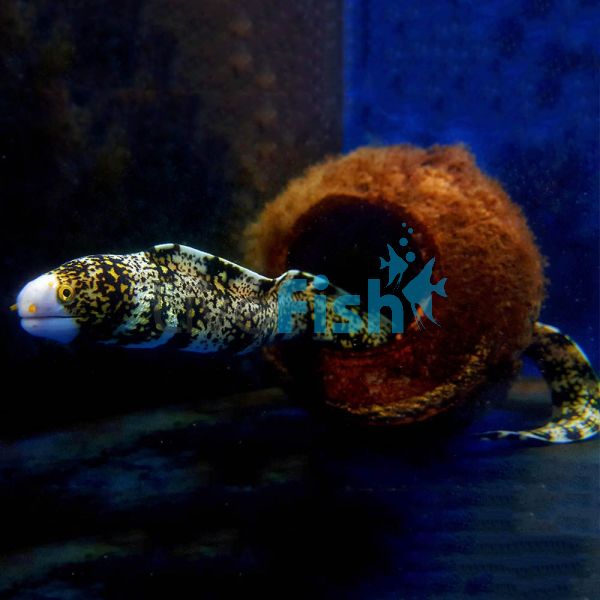Snowflake Moray Eel SML
This amazing specimen of an eel is well suited to aquarium life and perfect for beginner moray owners due to its hardiness and inquisitive lively nature.
The Snowflake Moray Eel can grow up to 36 inches in length and has a dirty white body that is blotched with black vertical bars and yellow polka dots. Its vibrant yellow eyes really make this a stunning species of eel.
There are no known differences between the sexes and they have not been bred in captivity successfully yet. Some think that the Snowflake Moray Eels are hermaphrodites like other eels that come from the same family.
These creatures have terrible eyesight and will "taste" the water column to detect food much like snakes do on land. This means that it can be tough for them to differentiate food and your finger so be extra careful as these guys can pack a nasty bite.
They are found all over the Indo-Pacific region from Baja California and Mexico all the way over to East Africa and the Red Sea. It hides and lives solitary among rocks and reef flats of shallow lagoons and seaward reefs. They have been spotted at depths of up to 30 meters deep.
Tank Recommendations for the Snowflake Moray Eel
The smallest tank size for this species is 280 litres and you will need to provide plenty of rock work and overhanging coral to allow the eel to establish hiding places. Everything should be fixed and as stable as possible because the eel will actively try to bury its own pathway and can be quite destructive to your setup. They are heavy eaters so will need an excellent filtration system to keep the water quality high. Moray eels are also accomplished escape artists so make sure to have a tight-fitting tank lid because they have been known to fit through the smallest of holes and even remove aquarium lids entirely.
Suitable Tank Buddies
The Snowflake Moray will consume most small fish and crustaceans and as such will need tank buddies that are bigger and more aggressive than it is. More than one adult can be kept in the same tank as long as they are introduced to it at the same time.
Usually Compatible
Great options to combine with eels are large Angelfish, Grunts, and Groupers. You also shouldn't have any problems with Lionfish and Pufferfish. Snappers and Tangs would make wonderful tank buddies as well. Eels will not pick at or eat live corals but be careful that they are secured properly.
Sometimes Compatible
Triggerfish, Wrasses, and Rays can sometimes be problematic. Keep an eye on Squirrelfish and Hogfish too. Eels will sometimes prey upon certain species of crustaceans and Dwarf Angelfish. Boxfish and Butterflyfish can be housed together as long as they are sufficiently large enough not to be seen as prey. Other Eels may be kept together but introduce them to the tank at the same time.
Rarely Compatible
Smaller fish like Blennies and Basslets will be eaten. Clownfish, Cardinalfish, and Damselfish shouldn't be kept together for the same reason. Other species on which the eel may prey upon include Gobies, Goatfish, and invertebrates. Seahorses and Pipefish will have no chance either. As tough as this eel sounds it is still no match for a Shark so don't attempt keeping the two in the same tank.
Feeding your Snowflake Moray Eel
This species is carnivorous and in the wild will hunt for small crustaceans such as shrimps, crabs, and lobsters. Give them a variety of fresh/frozen shrimps and crabmeat along with thawed squid and fish flesh. Offer them food with tongs but never use your fingers. Be careful not to overfeed them and only offer them what they will consume in one sitting because they are messy eaters. Live ghost shrimp can be offered when it first arrives in your tank until the eel becomes acclimatised to thawed foods.
| Scientific Name | Echidna Nebulosa |
|---|---|
| Care Level | Moderate |
| Common Names | The Snowflake Moray Eel is also known as the Zebra Moray and the Starry Moray. |
| Diet | Carnivore |
| Fish Family | Muraenidae |
| Lifespan (years) | 4 |
| Max. Length (cm) | 92 |
| Min. Tank Volume (l) | 280 |
| Origin | Indo-Pacific |
| Reef Safe | Yes |
| Sociability | Semi-aggressive |
| Venomous | No |
| Water Conditions | 22.2-26.6° C (72-78° F), dKH 8-12, pH 8.1-8.4, sg 1.020-1.025 |



